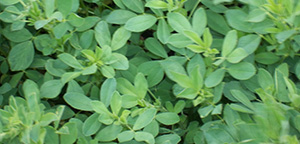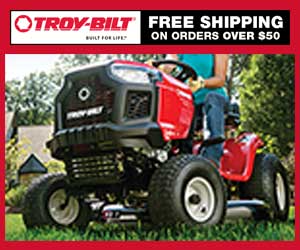
Alfalfa provides excellent-quality forage but is often underused due to misconceptions
By Dr. Amy Gill, PhD
Horses love the taste of alfalfa and for many, nothing could be better for them. Unfortunately, due to some myths about this forage, it is highly underused as a portion of the total ration. When used correctly, alfalfa can supply a great deal of natural nutrition and has some other physiological benefits as well.
Alfalfa is usually fed as a forage but is also offered as cubes and in chopped form. Few horse owners realize that alfalfa is also commonly included in pelleted concentrate rations and supplements. The addition of alfalfa to a feed provides excellent-quality protein, digestible fiber, digestible energy (calories) and calcium.
Alfalfa is highly recommended to be fed to gestating and lactating mares, growing horses, and horses that are intensively exercised and competing. Geriatric horses also do very well when alfalfa is included in their daily ration because it is so highly digestible compared to other long-stemmed, coarser forages.

Green in many ways
In Europe, Australia, and New Zealand, alfalfa is known as lucerne and it is called lucerne grass in south Asia..
Alfalfa, like clover, is a cool-season perennial legume and can live from three to 12 years, depending on variety and climate. The plant grows to a height of up to three feet, and has a deep root system that can be as wide as 15 feet. Because of this extensive root system, alfalfa is fairly resistant to drought conditions.
Alfalfa has a characteristic known as autotoxicity, which means that it is difficult for alfalfa seed to grow in existing stands of alfalfa. Therefore, most alfalfa fields are rotated with other species such as corn or wheat after several years before reseeding.
Legumes are unique because their root nodules contain bacteria, Sinorhizobium meliloti, that have the ability to fix nitrogen, so that the plant can product a high-protein feed regardless of how much nitrogren is present in the soil. Alfalfa's nitrogen-fixing abilities actually increase soil nitrogen content, which helps the growth of other crops that are rotated in the field. The alfalfa plant derives the nitrogen from the air, which is 78% molecular nitrogen. Alfalfa is truly a green plant in that it requires no additional soil nitrogen fertilization.
Alfalfa has the highest levels of nutrients of all the different varieties of forage crops. It normally is not used as pasture because it does not form a 'turf' and therefore is susceptible to damage from trampling, as opposed to grasses such as bermuda, fescue, and bluegrass. When grown on soils where it is well-adapted, alfalfa produces more yield per acre than any other forage crop.
California, South Dakota, and Wisconsin are the leading alfalfa-growing states. The upper Midwestern states produce about 50% of the output in the United States, whereas the Northeastern states produce about 10%, the Western states 40%, and the Southeastern states produce very little. Alfalfa has an amazing range of climates in which it can be successfully grown, including very cold and mountainous regions, rich temperate agricultural regions, Mediterranean climates and desert climates.

Concentrated packages
Alfalfa has higher values for percentage of protein, digestible fiber, and digestible energy than grass forages such as timothy or orchardgrass. Having a product of such high nutrient density utilized in feed formulations for horses is quite beneficial and it ensures nutrient intake is easily obtained. In other words, often a higher quality feed can be fed in a smaller amount than a lesser quality feed. This can be beneficial for the racehorses or any horse that requires large amounts of feed to meet nutrient requirements, as high-intensity training tends to make horses go off feed, making nutrient density extremely important. Feeding high-quality concentrates and supplements also makes feeding more economical.
Horseman often have the impression that alfalfa causes diarrhea, which is not true. In actuality, because of its solubility, alfalfa helps to keep fluid in the large intestine because it absorbs water, which is very beneficial and can help prevent impaction colics.
As usual, changing from one feed to another causes changes in the digestive tract microbial population and with the addition of alfalfa, the first thing one will notice is a softer stool. This is not diarrhea, it is simply the digestive tract adapting to a new substrate and one that is particularly good at retaining more fluid in the hindgut. This is a very desirable effect of feeding alfalfa.
For comparison, using alfalfa for its stool-softening effect is no different than feeding a wheat bran mash (another soluble fiber), which is a widely accepted practice in the industry. The problem with feeding wheat bran, however, is that doing so on a daily basis can cause serious mineral imbalances in horses, because wheat bran contains more phosphorus than calcium (inverted ration) whereas the calcium-to-phosphorus ratio in alfalfa is correct.
Grass hays such as timothy and orchardgrass, on the other hand, contain much less soluble fiber and more lignin than alfalfa, which does not do as good of a job of keeping the large intestine well hydrated and is often lower in protein, vitamins, and minerals than alfalfa. So feeding alfalfa not only helps keep the hindgut well hydrated, but also provides superior nutrition than coarser, bulkier forages.
Horseman should remember that soft, hydrated, easy-to-pass manure is much preferable to hard dehydrated manure that may lead to impaction colic if not quickly corrected. If the horse is healthy, has a bright eye, appears happy, and is doing what it is supposed to do well, soft manure is not a problem.
Alfalfa benefits
The importance of a high plane of nutrition becomes critical when feeding certain classes of horses as stated above.
Gestating broodmares have increased requirements for all nutrients starting the eighth month of pregnancy and should be fed a diet that includes alfalfa. Feeding good-quality forage, including alfalfa hay or in the form of pellets,cubes, or with a ration that incorporates alfalfa meal, is the most natural way to help meet these requirements. Once lactation begins, the mare's requirements can nearly double and again, the best way to help supplement nutrients is through the use of this excellent-quality forage.
Lactating mares will utilize the extra calories and calcium found in alfalfa to help produce high-quality milk for their foals. Interestingly, alfalfa is believed by some to be a galactagogue, a substance that induces lactation.
Growth also requires nutrient intake levels beyond maintenance of normal metabolism.
Using alfalfa producs as forage for young horses is very beneficial because it is much more digestible compared to grass hays. Young horses do not have the full ability to ferment fiber until they are about a year old. Feeding higher insoluble fiber forages such as timothy or orchardgrass hay or poorer quality forage sources often results in "hay belly". Therefore, feeding only highly digestible fiber such as alfalfa, clover, and beet pulp is recommended for the young growing horse.
The higher protein levels of alfalfa compared with grass hay will also help the young growing horse develop muscle tissue properly. Protein is not a contributing factor to developmental disorders. Imbalances in the nutrients of the ration as a whole and feeding too much starch in the diet has been shown to cause these problems.
The high calcium content of alfalfa is very beneficial to horses in training, as it helps to buffer stomach acid and thus reduce the risk of developing stomach ulcers. The low pH conditions in the stomach can damage the gastric lining. A research study compared a high-protein, high-calcium diet of alfalfa and grain to a low-protein, low-calcium bromegrass and grain diet for uclcer incidence. Horses fed the alfalfa and grain diet had a higher stomach pH, resulting in significantly fewer and less severe gastric ulcers compared with the horses receiving the bromegrass and grain diet.
Young horses entering training have a higher calcium requirement than their pastured counterparts due to demineralization of bones as a result of confinement to a stall (and lack of sprinting exercises that force the bone to adapt through remodeling the bone). Feeding alfalfa as forage as well as a component of the concentrate is an excellent way to help meet the elevated calcium requirement of these horses.
Geriatric horses can be a challenge to feed. Many become thin and underweight as they age. This occurs because the ability to digest, metabolize, and absorb nutrients out of the hindgut becomes reduced with advancing age. The energy density and highly digestible fiber in alfalfa make it a good choice for getting excellent-quality nutrition into the aged horse. The protein, calcium, and phosphorus in alfalfa are highly digestible and will help the older horse remain healthy and in good weight.
Alfalfa is a very versatile, highly nutritious, safe, and paltable feed for horses. For horses with high nutrient requirements such as those that are racing, gestating, lactating, and growing, alfalfa is highly suitable as part of the total ration. Alfalfa has been shown to reduce gastric ulcers in horses and it prevents the hindgut from dehydrating. Do not be afraid to feed alfalfa; it is excellent for the general health and well-being of the horse.

About the Author
Dr. Amy M Gill is an equine Nutritionist who specializes in metabolic, growth, exercise and immune related disorders of the performance horse. She has formulated the Equi-Force Equine Products (www.equiforce.com) Inc These products were formulated with the goal of helping to alleviate clinical symptoms associated with developmental orthopedic disorders, assist in the repair of damaged or abnormal bone and soft tissue, correct metabolic imbalances, improve tolerance to exercise and prevent muscle myopathies in the performance horse.
Dr. Gill is an avid equestrian competitor and is currently campaigning Caesar, a blue eyed, cremello snow cap appaloosa as an eventer. Dr. Gill can be reached at drgill@equiforce.com
































